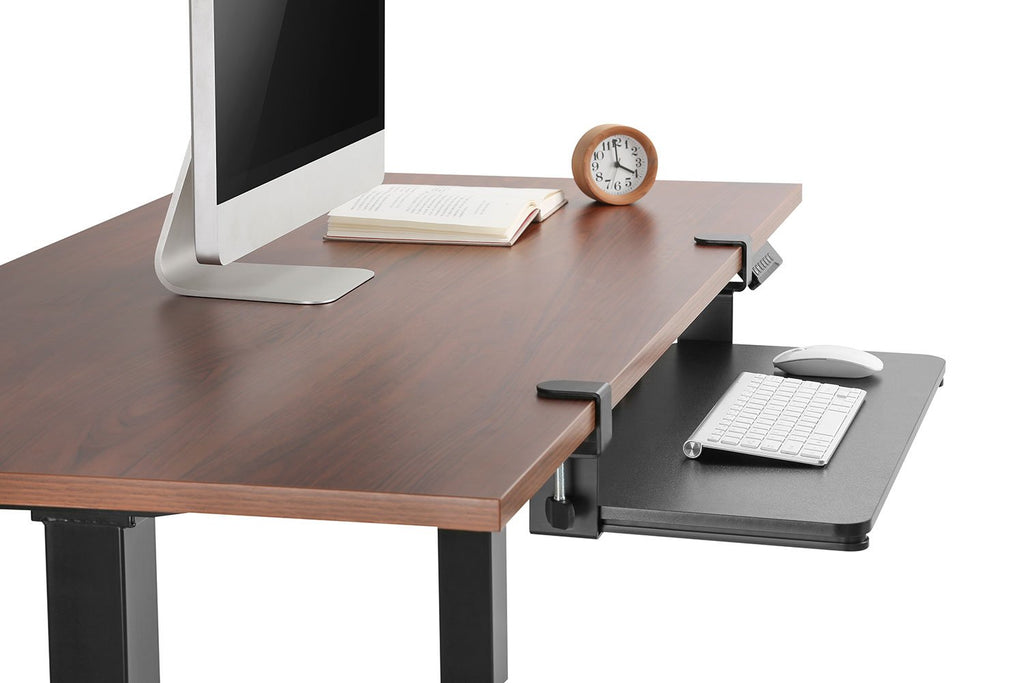The Basics of Keyboard Tray Ergonomics

A Brief Overview of Keyboard Tray Ergonomics
Using a keyboard directly on a desk causes two issues - fatigue and carpal tunnel syndrome. Desks are of different heights and sometimes users find themselves stretching out their arms to reach the keyboard.
Keyboard tray ergonomics deals with the problem of proper form and posture while typing. Correctly aligning your wrists means you can type freely and without strain. Most keyboard trays attach to the desk and can be titled in various angles to accommodate users.
Benefits of Keyboard Tray Ergonomics
Here’s a list of the most common benefits of employing keyboard tray ergonomics in the office or home space.
- Proper Height Adjustment - Desktop surfaces can be really high and a keyboard tray can help alleviate this problem. A keyboard tray helps you achieve a negative tilt of 15 degrees or more when sitting. You can adjust this when standing for optimal comfort.
- Easy to Mount - You can set them up below your desk or attach them to any surface. Keyboard trays
- Promotes Good Form - Typists lay their arms flat when typing and work with poor form. Sometimes they’re unaware of it. A good keyboard tray can help correct alignment and make a significant difference in their typing posture.
- Cost-Effective - It’s a lot more cost-effective to attach a keyboard tray to a desk than buy a new desk altogether. Keyboard trays are an economical investment for those who want to stay productive in the office.
What is Ergonomics?
Ergonomics is the science and technology used to optimize productivity in the workspace. It involves making everyday adjustments that fit the anthropometries of different users and ensuring they enjoy adequate comfort when working. Basically, ergonomics prevents workplace injuries and helps employees do their jobs better. For example, the Slide Keyboard Tray and Mouse Platform are able to slide underneath most surfaces and provide a stable mount, letting users type freely without expressing any stress in the elbow joints.
The goal of ergonomics is to take the stress off from ligaments and muscles in the body. Good ergonomics is why people change positions often or use standing desks. Taking pressure off when hitting keystrokes is another objective of keyboard tray ergonomics. Reduced strain on fingers can mean less room for typos, errors, and improved speed.
There are many different types of keyboard tray solutions available in the market. Designs are customized based on user requirements and preferences. The most common ones are:
Articulating Keyboard Trays - These keyboard trays are designed for desks that are too low. For users who have difficulty typing and have to reach out to their keyboards below, these are fantastic solution.
- Standing Keyboard Trays - Sit to stand keyboard trays and standing keyboard trays are viable options for users looking for versatile typing ergonomics solutions. These sit to stand trays can be even mounted on walls and tables, additionally.
- Pull Out Trays - Just as their name implies, pull out keyboard trays are clamped beneath desks and pulled out. These have an angle adjustment feature usually and can be tilted to varying degrees. Some of these products even let users swivel them left or right for easily switching positions.
Conclusion
When ordering a keyboard tray, make sure there are no tracks below the desk that could interfere with the mount. Review the space behind your workstation before you set it up as well and ensure there are no obstructions.
